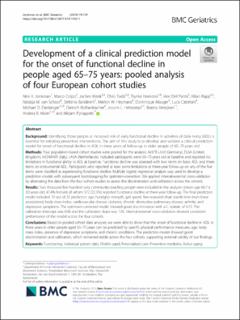| dc.description.abstract | Background
Identifying those people at increased risk of early functional decline in activities of daily living (ADL) is essential for initiating preventive interventions. The aim of this study is to develop and validate a clinical prediction model for onset of functional decline in ADL in three years of follow-up in older people of 65–75 years old.
Methods
Four population-based cohort studies were pooled for the analysis: ActiFE-ULM (Germany), ELSA (United Kingdom), InCHIANTI (Italy), LASA (Netherlands). Included participants were 65–75 years old at baseline and reported no limitations in functional ability in ADL at baseline. Functional decline was assessed with two items on basic ADL and three items on instrumental ADL. Participants who reported at least some limitations at three-year follow-up on any of the five items were classified as experiencing functional decline. Multiple logistic regression analysis was used to develop a prediction model, with subsequent bootstrapping for optimism-correction. We applied internal-external cross-validation by alternating the data from the four cohort studies to assess the discrimination and calibration across the cohorts.
Results
Two thousand five hundred sixty community-dwelling people were included in the analyses (mean age 69.7 ± 3.0 years old, 47.4% female) of whom 572 (22.3%) reported functional decline at three-year follow-up. The final prediction model included 10 out of 22 predictors: age, handgrip strength, gait speed, five-repeated chair stands time (non-linear association), body mass index, cardiovascular disease, diabetes, chronic obstructive pulmonary disease, arthritis, and depressive symptoms. The optimism-corrected model showed good discrimination with a C statistic of 0.72. The calibration intercept was 0.06 and the calibration slope was 1.05. Internal-external cross-validation showed consistent performance of the model across the four cohorts.
Conclusions
Based on pooled cohort data analyses we were able to show that the onset of functional decline in ADL in three years in older people aged 65–75 years can be predicted by specific physical performance measures, age, body mass index, presence of depressive symptoms, and chronic conditions. The prediction model showed good discrimination and calibration, which remained stable across the four cohorts, supporting external validity of our findings. | en_US |

